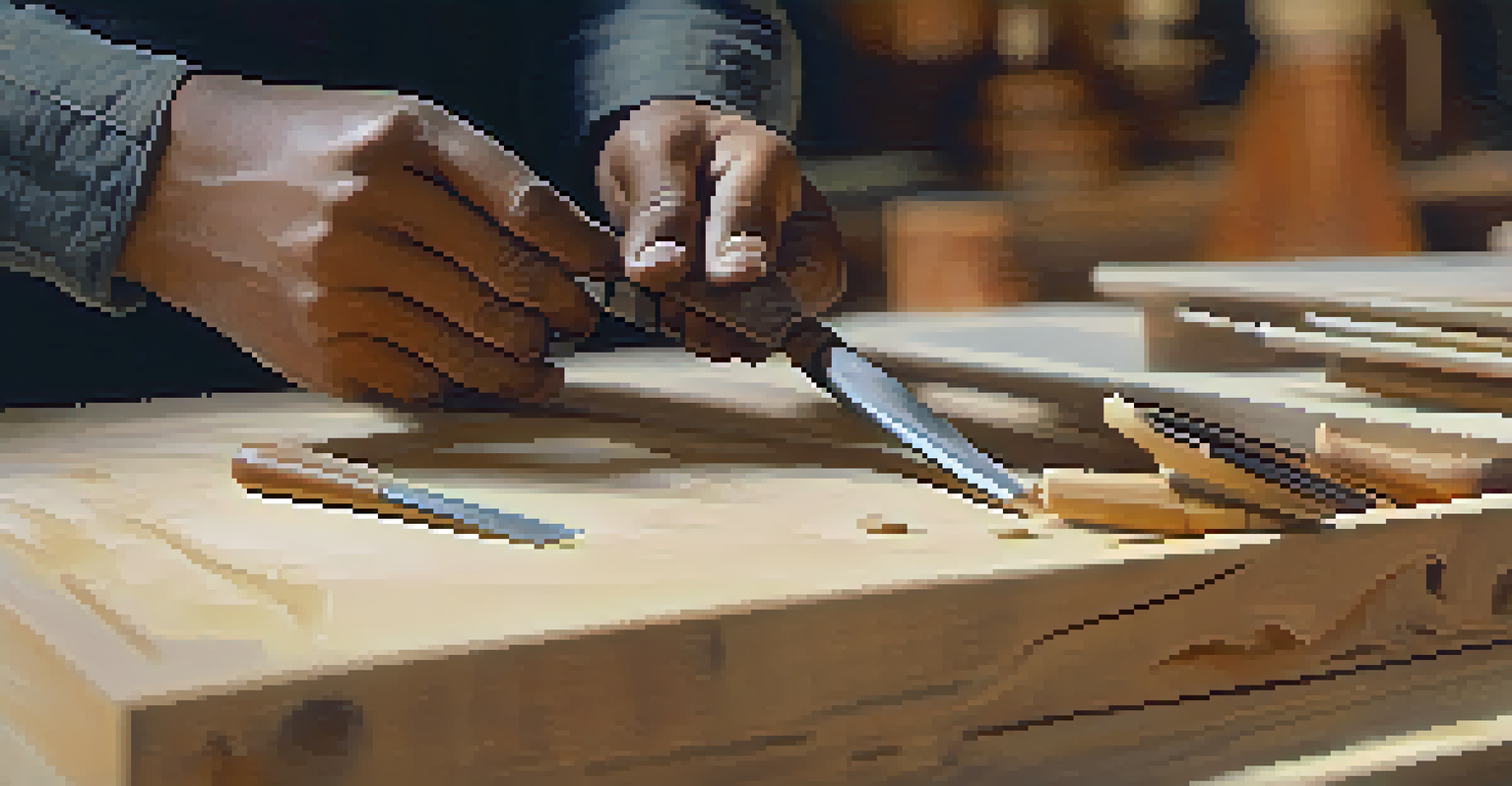The Importance of Carving Tool Maintenance for Safety

Understanding the Risks of Dull or Damaged Tools
When it comes to carving, using dull or damaged tools can lead to accidents. A dull blade requires more force, increasing the risk of slipping and causing injury. Moreover, damaged tools may not perform as expected, leading to unexpected accidents during the carving process.
The right tool for the right job is essential, but a sharp tool is a necessity.
Think of it this way: using a dull knife is like trying to slice through a loaf of bread with a butter knife. You’re more likely to slip and cut yourself, rather than make a clean cut. This principle holds true for carving tools as well, highlighting the need for sharp and well-maintained equipment.
In essence, ensuring your tools are in top condition isn’t just about achieving the best result in your carving; it’s about keeping yourself and those around you safe. Regular maintenance can significantly reduce these risks.
The Role of Regular Maintenance in Tool Performance
Regular maintenance of carving tools is essential for optimal performance. Just like a car needs regular oil changes to run smoothly, your carving tools benefit from routine care to remain effective. This includes sharpening blades, cleaning, and checking for wear and tear.

For instance, a well-sharpened chisel glides through wood with ease, allowing for precision and control. On the other hand, a neglected chisel can cause splintering and uneven cuts, frustrating the carver and potentially leading to injuries.
Dull Tools Increase Injury Risk
Using dull or damaged carving tools can lead to accidents due to increased force and unexpected performance issues.
By committing to regular maintenance, you not only enhance the performance of your tools but also heighten your enjoyment of the carving process. It's a simple way to ensure that your creative work goes as smoothly as possible.
Essential Maintenance Practices for Carving Tools
To keep your carving tools in great shape, there are a few essential maintenance practices you should adopt. First, always clean your tools after use to remove any wood chips or debris. A quick wipe with a cloth can prevent rust and prolong the life of your tools.
It’s not the tools you have faith in. Tools are just tools. They work, or they don’t work. It’s people you have faith in or not.
Next, sharpening your blades should be a regular part of your routine. Using a whetstone or a honing guide can help maintain the edge, making your tools safer and more effective. Remember, a sharp tool is a safe tool!
Lastly, consider oiling your tools occasionally to protect them from moisture and rust. A little bit of oil goes a long way in ensuring your tools remain in prime condition, ready for your next carving project.
The Importance of Proper Storage for Carving Tools
Proper storage is another critical aspect of maintaining your carving tools. Storing them in a dry, safe place prevents rust and damage while ensuring they’re easily accessible when you need them. Wooden storage boxes or padded cases can offer excellent protection.
Imagine trying to find a tool buried underneath a mountain of clutter—frustrating, right? By organizing your tools in a thoughtful manner, not only do you protect them, but you also save time and energy during your carving sessions.
Regular Maintenance is Essential
Routine care like sharpening and cleaning keeps carving tools effective, ensuring both safety and enhanced performance.
Additionally, consider using blade guards or sheaths to protect sharp edges when storing your tools. This simple step can prevent accidental cuts and prolong the longevity of your equipment.
Recognizing the Signs of Tool Wear and Tear
Being able to recognize the signs of wear and tear on your carving tools is vital for maintaining safety. Look for any chips, cracks, or rust on blades, as these can compromise their effectiveness and safety. If you notice any of these issues, it’s best to address them immediately.
For example, a chipped blade can lead to uneven cuts and may even break during use, posing a danger to the carver. Keeping an eye on your tools and addressing wear promptly can help prevent accidents before they happen.
Routine inspections of your tools will help you catch these signs early on, ensuring that you can carve with confidence and safety.
Understanding When to Replace Carving Tools
Despite our best efforts in maintenance, there comes a time when replacing carving tools is necessary. If a tool is consistently performing poorly, even after sharpening and cleaning, it may be time to invest in a new one. Remember, safety should always come first.
For instance, if a once-reliable gouge is now causing more frustration than creativity, it could hinder your artistic flow and increase the risk of accidents. Investing in high-quality tools can be more cost-effective in the long run, as they often provide better performance and safety.
Proper Storage Prolongs Tool Life
Storing carving tools correctly prevents rust and damage, making them easily accessible while protecting their sharp edges.
Ultimately, don’t hesitate to replace tools that no longer serve you well. A fresh tool can reignite your passion for carving while ensuring a safer and more enjoyable experience.
The Connection Between Tool Maintenance and Creativity
Interestingly, there’s a direct connection between tool maintenance and creativity. When your tools are well-maintained, you’ll find that your carving sessions become smoother and more enjoyable. This allows you to focus on your art rather than struggling with equipment issues.
Think of it like this: a painter with a clean palette and sharp brushes can create effortlessly, while one with dried paint and worn brushes may feel stifled. Similarly, when your carving tools are in excellent condition, you can unleash your creativity without hindrance.

In essence, investing time in tool maintenance not only enhances safety but also fosters an environment where creativity can thrive. A well-maintained tool is like a trusted friend, always ready to help you express your artistic vision.